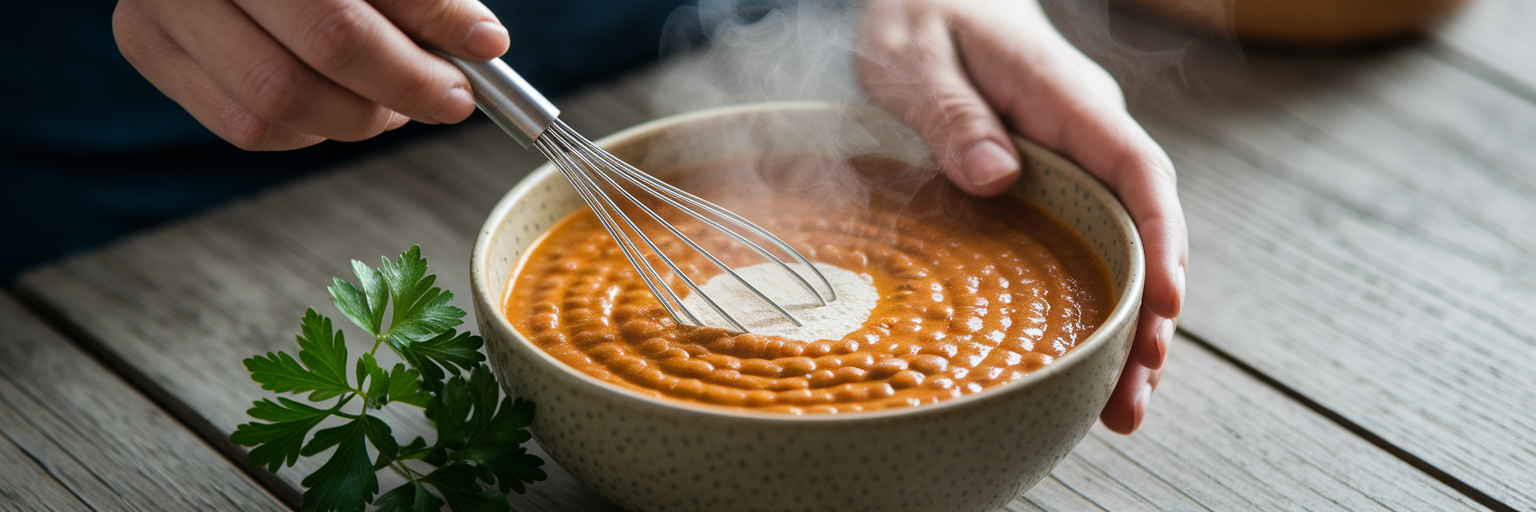We all know that feeling of trying to fit more protein into our day. For many, the default is a quick shaker bottle smoothie, but what if you could seamlessly add that nutritional boost to the meals you already enjoy? Vegan protein powder is more than just a post-workout supplement; it's a versatile kitchen staple that can enrich everything from your morning pancakes to your evening soup.
Learning how to cook with vegan protein powder opens up a new way to support your wellness goals without overhauling your entire diet. It’s about making small, simple upgrades that add up. The key is knowing which powder to use and how to use it. Let's get started.
Getting Started with Vegan Protein in Your Kitchen
Bringing vegan protein powder into your cooking is surprisingly simple. Think of it as a functional flour or a nutritional thickener. For busy schedules, it’s an incredibly convenient way to make sure your meals are satisfying and keep you full longer. The first step is choosing the right tool for the job, because not all protein powders are created equal.
Different plant-based proteins have unique flavors and textures. An unflavored pea or soy protein is fantastic for savory dishes where you don't want a hint of vanilla clashing with your herbs. Hemp protein, with its nutty taste, is a natural fit for earthy baked goods like muffins or dense breads. Understanding these nuances is the first step to success.
When you're just starting, remember the "less is more" principle. You don't need to dump a full scoop into your recipe right away. Begin with just a tablespoon or two to see how it affects the flavor and consistency. This small step helps you build confidence and avoid the common pitfalls that can turn a great meal into a chalky disappointment.
| Protein Type | Flavor Profile | Best For | Things to Note |
|---|---|---|---|
| Pea Protein | Mild, slightly earthy | Smoothies, soups, stews, baking | Can be slightly gritty if not blended well. Very versatile. |
| Soy Protein | Neutral, creamy | Baking, smoothies, creamy sauces | Creates a smooth texture, making it great for creamy recipes. |
| Hemp Protein | Nutty, earthy | Baking (muffins, breads), oatmeal | Its distinct flavor works well in earthy baked goods but can overpower delicate dishes. |
| Brown Rice Protein | Slightly sweet, mild | Baking, smoothies, savory dishes | Can sometimes have a chalky texture; pairs well with strong flavors. |
Perfecting the Protein-Packed Smoothie

The smoothie is the classic home for protein powder, but many of us have been let down by a gritty texture or a lingering aftertaste. The good news is that a perfectly smooth, delicious protein smoothie is easy to achieve once you know a few simple tricks. It’s not about masking flavors; it’s about building a better smoothie from the ground up.
Building a Better Smoothie Base
A great smoothie follows a simple formula. For a consistently delicious result, combine these three elements:
- A Creamy Liquid: While any plant-based milk works, oat milk or cashew milk provides a richer, creamier foundation that helps suspend the protein powder.
- Your Protein Powder: Start with one scoop. You can always add more, but it's harder to take it away.
- Frozen Fruit: Using frozen fruit, especially half a frozen banana, is non-negotiable for a thick, milkshake-like consistency. It chills and thickens the smoothie without watering it down like ice does.
How to Eliminate Chalkiness and Improve Texture
Here’s the secret to make protein powder taste better and feel smoother: add a source of healthy fat. Fats help emulsify the powder, breaking down any grittiness and creating a velvety texture. Just a tablespoon of one of these is all you need:
- Almond or cashew butter
- A quarter of an avocado
- A spoonful of chia or flax seeds
Natural Flavor Enhancers to Mask Aftertaste
If your protein powder has a slightly earthy note, a few simple kitchen staples can balance it out. These natural enhancers complement the flavors instead of just covering them up. For a rich, satisfying drink, consider adding a scoop of our chocolate vegan protein, which pairs beautifully with coffee or banana. You can also try:
- A dash of cinnamon or nutmeg
- A splash of pure vanilla extract
- A tablespoon of unsweetened cocoa powder
And remember, you don't always need a blender. A scoop of protein powder can be stirred directly into your morning oatmeal or even a cup of hot coffee for a quick and easy boost.
The Secrets to Successful Protein Baking
The idea of baking with vegan protein powder can feel intimidating. We’ve all heard stories of protein brownies turning out like rubbery bricks. But it’s not a matter of luck; it’s a matter of science. With a few key guidelines, you can easily add a protein boost to muffins, pancakes, and cookies without sacrificing texture.
The 'One-Third' Rule for Flour Substitution
This is the most important rule in protein baking: only replace up to one-third of the flour in a recipe with protein powder. For example, if a recipe calls for one cup of flour, use 2/3 cup of flour and 1/3 cup of protein powder. Protein powder is extremely absorbent and contains no gluten, so using too much will soak up all the moisture and result in a dense, dry final product. As baking experts at VegFAQs confirm, exceeding this ratio is the most common reason for failed protein baked goods.
Boosting Moisture to Counteract Dryness
Since protein powder absorbs liquid like a sponge, you need to add extra moisture to your batter to keep things from drying out. This is where simple, whole-food ingredients come in handy. For every scoop of protein powder you add, consider also adding about a quarter cup of a moisture-rich ingredient like:
- Unsweetened applesauce
- Mashed banana
- Pumpkin or sweet potato puree
- Vegan yogurt
Another quick tip: be careful not to overmix your batter. Once the ingredients are just combined, stop. Overmixing develops gluten and can make your baked goods tough, a problem that’s only amplified by the density of protein powder.
Easy Baking Recipes for Beginners
If you’re new to protein baking, start with forgiving recipes. Pancakes, waffles, and muffins are great entry points because their batters are naturally moist and don't rely on a delicate structure. They are a fantastic canvas for experimentation. To get you started on the right foot, you can try one of these 3 easy vegan protein recipes you'll actually crave.
Adding a Savory Boost to Everyday Meals

When we think of protein powder, our minds usually go to sweet treats. But one of its most underutilized powers is in the world of savory cooking. Adding a scoop to your daily meals is a fantastic way to create more balanced, satisfying dishes without anyone even knowing it’s there. This is where you can get truly creative with savory protein powder recipes.
The best candidates for a savory protein boost are dishes with a liquid base where the powder can dissolve completely. Think soups, stews, curries, and creamy pasta sauces. The powder acts as a slight thickener while enriching the meal.
However, there is one rule that is absolutely non-negotiable: you must use an unflavored, unsweetened protein powder. We can all picture how a hint of vanilla or stevia would instantly ruin a hearty tomato sauce or a lentil soup. Always check the label to ensure your powder is truly neutral.
Finally, follow the "low-heat rule." High, direct heat can cause protein to denature and clump, creating a gritty texture. The fix is simple: stir the powder in at the very end of the cooking process, once the dish is off the heat. This allows it to dissolve smoothly without any risk of clumping. For more inspiration on enriching your meals, feel free to browse our blog for more ideas.
Simple High-Protein Vegan Meal Ideas
Now that you have the techniques down, it's time for some inspiration! Integrating protein powder into your diet should feel easy and delicious, not like a chore. Here are some simple ideas for high protein vegan meals to get you started, from breakfast through dessert.
Protein-Powered Breakfasts
- Overnight Oats: Stir a scoop of vanilla or unflavored protein powder into your oats, chia seeds, and plant-based milk before refrigerating overnight.
- Fluffy Protein Pancakes: Use the "one-third" rule to replace some of the flour in your favorite pancake recipe for a breakfast that keeps you full all morning.
- Savory Tofu Scramble: Whisk a tablespoon of unflavored pea protein into your tofu scramble seasoning to add an extra boost and a creamier texture.
Satisfying Lunches and Dinners
- Creamy Tomato Soup: Stir a scoop of unflavored protein powder into your soup just before serving for a richer, more filling meal.
- Vegan Mac and Cheese: Whisk unflavored protein powder into your cashew or vegetable-based cheese sauce to make it extra satisfying.
- Hearty Lentil Curry: Add a scoop of unflavored protein to your coconut milk-based curry sauce at the end of cooking for a thicker, more nutrient-dense dish.
Nutrient-Dense Snacks and Desserts
- No-Bake Energy Balls: Combine rolled oats, nut butter, a sweetener like maple syrup, and a scoop of protein powder. Roll into balls for the perfect grab-and-go snack.
- Simple Chia Seed Pudding: Whisk protein powder in with your chia seeds and plant-based milk for a pudding that’s both a treat and a nutritional powerhouse.
With so many delicious possibilities, you can find the perfect plant-based protein for your kitchen by exploring our full collection of products.
Common Cooking Mistakes and How to Fix Them
Even with the best intentions, things can sometimes go wrong in the kitchen. Don't worry, most common protein powder cooking mistakes are easy to fix and even easier to avoid once you know what to look for. Here’s a quick troubleshooting guide.
Mistake: Using Too Much Powder.
This is the number one culprit behind dry baked goods and chalky sauces.
The Fix: Stick to the rules. For baking, never replace more than one-third of the flour. For liquids like soups or smoothies, start with one scoop per serving and adjust from there.
Mistake: Not Dissolving It Properly.
Dumping a scoop of powder directly into a hot soup or thick batter is a recipe for clumps.
The Fix: Use the "slurry" technique. In a small bowl, whisk the protein powder with a few tablespoons of liquid from your recipe until it forms a smooth paste. Then, stir this slurry into your main dish. It will incorporate seamlessly.
Mistake: Ignoring the Powder's Inherent Flavor.
Using a vanilla-flavored powder in a savory dish is an obvious error, but even unflavored powders have subtle tastes.
The Fix: Taste your protein powder on its own. Mix a tiny bit with water to understand its natural flavor profile. A slightly earthy pea protein might be great in a stew but less ideal in a delicate sauce.



